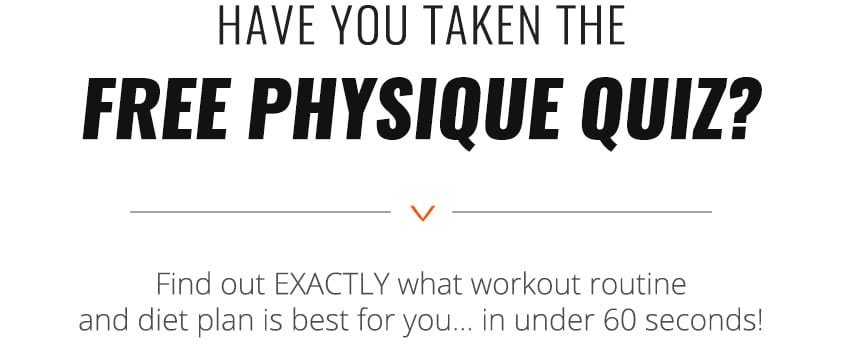When it comes to bodybuilding, there are 2 main styles of training: full body and split.
Full body training means you target all of your major muscles groups every single workout. Split training means you only target 1 or 2 muscle groups per workout. For example:
| Full Body | Split | |
|---|---|---|
| Monday | Everything | Chest |
| Tuesday | Rest | Legs |
| Wednesday | Everything | Back |
| Thursday | Rest | Shoulders |
| Friday | Everything | Arms and Abs |
In this article, I’ll explain 3 reasons why full body training is superior to split training for building mass and getting stronger.
#1: Elevated Muscle Protein Synthesis
Studies show that when you lift weights your rates of muscle protein synthesis are raised for about 36 hours. This is what leads to muscle growth and increased strength.
In other words, your body is building muscle for 36 hours after each time you hit the gym.
When you do a full body routine you’re raising these rates of muscle protein synthesis for your entire body 3 times per week. When you do a split routine, you’re only raising the rates of muscle protein synthesis for each muscle group once or twice per week. Simple math tells us that 3 is greater than 1 (or 2).
More frequent spikes in muscle protein synthesis will lead to quicker growth and development.
#2: More Quality Reps per Week
There’s one major point of contention every proponent of a split routine will make in response to my above argument. This is that with a split routine, even though you only hit the chest once per week, when you hit it, you hit it hard.
Unfortunately, this doesn’t lead to equal spikes in muscle protein synthesis over the course of a week. For example, you might only be targeting your chest with five sets of bench press in a full body workout. On a chest day in a split you would do those five sets of bench press and then follow it up with multiple sets of incline bench press, chest flies, and push-ups – a lot more volume than the five sets of bench press you would’ve done using a full body routine.
The problem with this argument is that after five sets of heavy bench press, your chest is already quite fatigued. You won’t be able to bring the same intensity to subsequent chest exercises.
In a full body routine, you get the five intense sets of bench press, and then switch body parts and do something like heavy rows using your back (that’s still fresh). In a split, you switch to incline bench, but can only do a percentage of your true capability, because your chest is already beat up from the flat bench press you started with.
The result is that you get significantly diminishing marginal returns. You extract far less value out of each subsequent exercise. This problem is side stepped with a full body routine, where you get the intense, bang-for-your-buck reps and then rest so you can get another dose of them a couple of days later, rather than having to wait a full week.
#3: More Passion and Intensity
The last reason that full body training routines are superior is a mental one.
Because you’re only lifting weights three times per week, your enthusiasm will be higher each time you’re at the gym. This will translate to more intensity… and this will ultimately lead you to pushing yourself harder and making more gains.
Also, because you’re constantly switching between muscle groups, you’re more likely to stay acutely focused on the exercise at hand.
Conclusion: Full Body Training is Superior
The benefits of using a full body routine should be obvious to you at this point.
If not, consider this: all professional bodybuilders before the 60s or 70s used full body routines to build their impressive physiques. This includes guys like Arnold Schwarzenegger, Steve Reeves, Reg Park, and Leroy Colbert.
And while it’s true that today’s bodybuilders are bigger than they were back in the day, you must realize that the amount and variety of steroids used today is exponentially higher than ever before. This is the reason for the bigger physiques, not because some of them have switched to split routines.




Yep, efficiency is always key, that why I like compound exercises. Then once you have a base, you can delve into isolation
Boom. This is precisely the approach that everyone should take. Without strength in the basic movement patterns you risk damaging your posture and long term health – not to mention sacrifice most of your “noob” gains.
Split routines over full-body for me.
Full body is way superior to splits, the results speak for themselves.
MY WEIGHT IS 144 KG … I LOVE TO DO FULL BODY WORK OUT … ROUTINE – 5 MINUTE – CROSS TRAINER , 15 MINUTE – CYCLE , LEG EXTENSION , SEATED ROW , LET POOL DOWN , SHOULDER PRESS AND CHEST DECK FLY
IS IT RIGHT FORM ME TO WEIGHT LOSS ?
Your arguments make sense, but every scientific comparison between FBW and SPLIT does not show any significant differance. I am doing FBW but i try to be objective as well.
i am confused science says…just look at the biggest dudes in the gym, ask them what they are doing, they all do splits, ask science to explain that. Everyone does anabolic’s but the biggest dudes are the guys who split. Not the full body guys.. at some stage you need more volume or weight to grow and there is not enough time in a full body work out. Science says if science is wrong everyone is wrong who says FBW are more growth with splits.
Sometimes you need more frequency and sometimes you need more volume.
Its a combination of FBW and Splits. the truth is always in the middle and knowing when its time to do splits or when its time to do FBW, or just increase your anabolic use…either works.
Enthusiasm? I might agree to this… It did actually happen to me when I switch to Full Body Workout 3 times per week. I get more excited thinking that yeah…. tomorrow is my rest day so I need to eat nutritious to power me up for my next workout after tomorrow. ^_^
Anyhow, I used to do split workout before like Day1->Chest&Tri Day2->Back&Bi then Day3->Legs and last Day4->Shoulder&Arms. That’s too much time spending in the Gym in your whole week.. I mean, should we live most of our lives in the Gym? jejejeje
So, I shorten it into Day1–>Chest&Back, Day2–>Legs Day3–>Shoulder&Arms then Rest Day then Day4–>Full Body Workout then Rest Days, and again repeat Day1 to Day4. But still more days spending in the Gym… So, what happen next was, I re-program again my workout to Day1–>Full Body REST then Day2–>Full Body then REST and Day3–>Full Body then Rest & Rest, then repeat again. and my games usually this way, whatever workout I didn’t do on Day1 I’m doing it on Day2 then on Day3, respectively. Example: if on Day1 I have Barbell Front Squat & Leg Press, on Day2 I have Deadlift or Romanian Deadlift & Hip Thrust and sometimes with walking Lunges, then on Day3 I’ll have my Barbell Back Squat & Superset of Leg Curl & Leg Extension OR walking Lunges if I didn’t played it on Day2 with Leg Curls & Leg Extension. That’s it! and others are history.
Have you ever met someone jacked says…i do full body.
Bodybuilders and jacked dudes, do splits..the result does speak for themselves.
I am 62 years old and I have been working out in the gym for about 2 years. i tried both routine,split and total body. Total body 3 times a week I have been more productive for me !
Based on science? Give me a break.
The only way to do split/lots of sets/frequent workouts and benefit is to be in your 20s, on PEDs, or both; for those who are natural, 30s & over, and care about their time, full body high intensity training is the only way to go. Your body needs to be stimulated to respond & adapt (workout), then fed so that it’ll grow during rest. Without enuff down time between workouts (stimulus), the adaptive affects are short circuited & gains are compromised. For reference, read & watch: Dr. Ellington Darden, Dr. Doug McGuff, Drew Baye & Jay Vincent
Das beste wäre bodybuilder bilder zeigen die 3x ganzkörper trainieren . Auch ihre satz und wiederholungszahl .
i agree with this article. and yes i have met many big dudes who do full body workout. and met skinny dudes who do split workouts.
I do do a full body routine every day and I totally agree with all opinions in this article